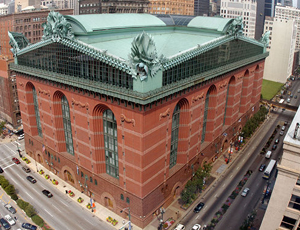Located in the South Loop, Harold Washington Library Center is CPL's main library.
Plan Your Visit to HWLC has information about what to see and do while you're here.
History
- In 1987, Mayor Harold Washington ordered a design/build competition for a new central library in the South Loop. The City Council authorized the competition and the $144 million bond issue to finance the project on July 29, 1987.
- Based on both design and cost criteria, an 11-member citizen jury selected the design by Thomas Beeby from Hammond, Beeby & Babka, Inc. as the winner on June 20, 1988.
- Groundbreaking took place October 13, 1988, using imported soil because the location at State and Van Buren streets was an asphalt-covered parking lot. Harold Washington Library Center Construction Photographs, 1988-1991 documents the construction.
- Dedicated October 4, 1991, HWLC opened October 7, 1991.
- Named for Harold Washington (1922-1987), the city's first African American mayor.
Architectural Highlights
More than an example of late 20th century American architecture, the ornamentation, iconography and allegorical figures that embellish Harold Washington Library Center are an homage to Chicago’s history and culture. Our video highlights the conception and construction of some of the building’s most popular features. The Special Collections & Preservation Division at Harold Washington Library Center holds the documentation of the work seen in this video.
Who Are Those Owls?
Five massive owls look down from the top of Harold Washington Library Center.
Architect Thomas Beeby originally envisioned a single owl over the building's entrance. He consulted Kent Bloomer, a nationally known sculptor of architectural ornamentation, to redesign his sketch. Bloomer, a professor at Yale University, enlisted a former student, sculptor Raymond Kaskey, to design the owl. Kaskey and Bloomer also collaborated on the building’s facade ornamentation.
Four 12-foot-high barn owls with 3-foot-high heads grace the corners of the building's roof. They're augmented by 75-foot-wide and 40-foot-high swirls of leaves and seed pods. Those ornaments represent growth and wisdom. Seed pods metamorphose into owls, the long-accepted symbol of knowledge. The owls are depicted in an aggressive stance, leaning forward with 8-foot-high wings. One foot clutches loose papers, while the other, with talons raised, is ready to strike.
The great horned owl is atop the main entrance of the building, on State Street. At 20 feet high with a 20-foot wingspan, it weighs three tons. Clutching an open book, this owl stands with wings spread, ready to take flight. An avid reader, the owl always returns his books.


